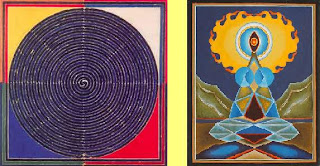Yet two years later his works are not selling anymore. Why? The fate of Jogen Choudhuri, Thota Vaikunthan, Laxma Goud and Sanjay Bhattacharya is no better. This inspite of the fact these artists were the best and highest selling just a few years back.
According to Neville Tuli of Osian, this fall in confidence is not a bad thing after all. Because it can only force out casual buyers who were till now interested in making quick bucks in art. But according to Tuli the serious buyers who were always interested in long term investments continue to operate in the market.

Laxma Goud and now Laxman Aley: Difficult to distinguish
Even though similarity in styles do not necessarily reduce the value of art, the Indian market has seen a sharp fall in prices of artists who have been found to be similar to other artists. Thus we can see that novelty in style is a prime ingredient in art becoming investible. However it must be remembered that many of India's best artists had shown similarities in styles and yet they continued to remain important artists. Most Bengal School artists for example made almost indistinguishable wash-paintings and for a long time Jehangir Sabbavala could not be identified with any signature style.
But those were different times. Today the art-lovers are getting to see international art. Buyers from abroad also look for novelty in art-styles and hence this is emerging as a major factor in art's novelty.
What distinguishes good artists from others is the originality of the concepts that they have developed. In Europe, most major artists are associated with original concepts in art like Picasso with Cubism, Monet with Impressionism, Pollock with Abstract Expressionism. Like wise in India original concepts are associated with path-breaking artists like Abanindranath Tagore, Jamini Roy, Rabindranath Tagore.

Chintan Upadhyay and Devajyoti Ray
Unfortunately not many new artists in modern times have tried very original concepts in art for a long time. Chintan Upadhyay's digital art, Devajyoti Ray's pseudorealism and Chitra Ganesh's Comic strip series are some of the novel moves in the direction of developing very original concepts.
Apart from original style and original concept, what determines the importance of an artist is the capability of the artist. No artist ever paint the same type of painting all their life. With age and with time, as the artist goes through the trials and tribulations and experiences of life, his or her art evolves in both form and style. Artists who have never changed their style tend reproduce and be repeatitive leading to fall in their novelty and attraction.

Ramachandran, another senior artist of great repute had in recent past moved completely away from his previous figurative art-works to completely new style of abstract installation art. Change is thus fundamental in the growth of an artist.
But change in art has to be evolutionary and sincere. Jeram Patel in recent times have changed his style and went for casual almost insincere works (Read more). Such change in style is however not a mark of an artist's dynamism but rather indicative of the diminishing creative energy of the artist. Sanjay Bhattacharya, Vaikunthan, Bose Krishnamachari can also be blamed for such casualness that ends up belittling art in itself.
Bose Krishnamachari's earlier work (left above) shows intricate work and planned execution while recent works (below left) shows simple interplay of colours with large space of monotomous colours. These works do show a change in style but they can hardly be called an evolution in style. Rather the change shows a casualness caused probably my the increasing market demand of the artist's works, which is quite unfortunate.
There are another set of artists like Manjit Bawa, Neeraj Goswami, Arpana Caur etc; people who have not changed anything ever since they have started working. Such repeatitive working is also impotent in their impact and art-lovers in course of time get engulfed in ennui.
There are thus very few senior artists who have shown such dynamism so to be able to change their style over a period of time. Such dynamism distinguishes a great artist from others. Many artists who had shown great style once, have shown their mediocrity in course of time, while many with humbler beginings have shown increasing strength with time.



0 Comments:
Post a Comment
<< Home